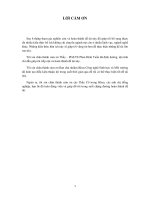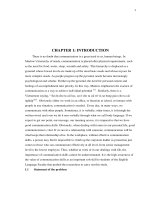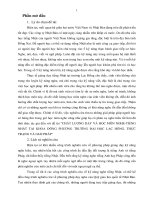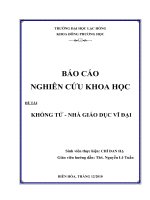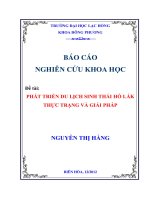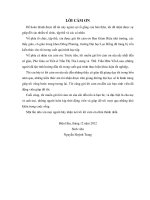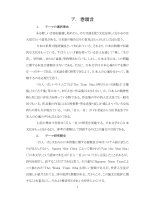Báo cáo nghiên cứu khoa học " DRAGON FRUIT QUALITY MANUAL " pptx
Bạn đang xem bản rút gọn của tài liệu. Xem và tải ngay bản đầy đủ của tài liệu tại đây (3.36 MB, 285 trang )
© AusAID 2006 VERSION: 1.0 10 November 2006
Copy Number: 1
© AusAID 2006 VERSION: 1.0 10 November 2006
Copy Number: 1
© COPYRIGHT (2006) AusAID, Australia. All Rights Reserved. No part of this publication may be
reproduced, stored in a retrieval system, transmitted, reported, or copied in any form or by any means
electronic, mechanical or otherwise without written permission of the copyright owner. Information
contained in this publication is confidential and is not to be disclosed in any form to any party without
the prior approval in writing of the Chief Executive Officer, AusAID, 62 Northbourne Avenue, GPO
Box 887, Canberra
ACT 2601, Australia.
© AusAID 2006 VERSION: 1.0 10 November 2006
Copy Number: 1
DRAGON FRUIT QUALITY MANUAL
Introduction
This manual has been developed to support the introduction of Good Agricultural
Practices to the Dragon fruit Industry of Vietnam. The manual is based on the
requirements of EUREPGAP (Euro-Retailer Produce Working Group Good
Agricultural Practice) at the farmer level and BRC (British Retail Consortium –
Global Standard: Food) standards as access to these markets is not possible unless
complete compliance with these standards is met.
The manual has been developed as an outcome of an AUSAID CARD project:
Developing GAP systems for Dragon fruit producers and exporters in Binh
Thuan and Tien Giang provinces 037/04VIE 2005 to 2007.
The manual describes how the Farmers; Packers; and Exporters of the Dragon fruit
Industry will comply with the requirements of the EUREPGAP (Version 2.1 – Oct
04), BRC (Issue 4, January 05) and HACCP (Hazard Analysis and Critical Control
Point). The manual also includes: Codes of Practice; Protocols; Recommended
Systems; Project training material; Compliance documentation samples; The Dragon
fruit farm Register; and other relevant project generated material. The Manual is a
living document and will be subject to continual improvement.
For the purpose of the CARD Project the approach taken has been to develop people
and systems at all levels within the Dragon fruit Industry (Research, Extension,
Exporter, Packer, Farmer) in the requirements of GAP, Food Safety/Security, and
Health and Safety issues. The initiative commenced with a Pilot demonstration and
will be systematically expanded. It is expected that, through this development, full
compliance with the standards will be met and access to high value markets will be
gained by increasing numbers of farmer and packers.
********************************
BRC Global Standards - Food will be applied to packer/exporter:
• Accredited certification bodies evaluate companies to confirm conformity of
product with the specified requirements laid down within the BRC Technical
Standards
• Evaluation by the certification bodies will be carried out at a specified
frequency to demonstrate the continued conformity of the certified product
within the required standard.
BRC copyright approval was given provided that the purchase of the BRC Global
Standard – Food is made for each packhouse. This Dragon fruit manual is to be
used in accordance with the CARD copyright requirements. The layout and format
of the BC Global Standard - Food has been used with BRC's approval for the
packer section of this manual. This was done to ensure that the "Fundamental"
BRC requirement (in red) is clearly identified at the beginning of each packer
subsection to indicate the purpose/requirement of the sub section. Within the
context of the BRC standard ‘fundamental’ requirements are those where
© AusAID 2006 VERSION: 1.0 10 November 2006
Copy Number: 1
certification will not be awarded if companies cannot satisfy these requirements
hence the special emphasis on these requirements.
The implementation of this manual must be delivered by suitably qualified
personnel.
Only those certification bodies who have accreditation to ISO/IEC Guide 65 with a
scope, which includes meeting the requirements of the standard (or actively seeking
accreditation to ISO/IEC Guide 65), shall carry out evaluations against a BRC
Standard and issue appropriate certificates.
Register of manual copies released:
Copy Number Copy Issued to English Vietnamese
1 AusAID 1 1
2 SOFRI 1 1
3 SOFRI 1 1
4 Pilot Project 1 1
5 HortResearch 1 1
6 HortResearch 1 1
7 HortResearch 1 1
********************************
To gain accreditation under EUREPGAP the farmer will be assessed by an
independent and Accredited Certifying Body:
EUREPGAP Control Points are split into three categories, ‘Major Must’, ‘Minor
Must’ and ‘Recommended”:
• MAJOR MUST (47 control points) – Requires 100% compliance to those
that are applicable
• MINOR MUST (98 control points) – Requires 95% compliance to those
that are applicable
• RECOMMENDED/SHOULD (65 control points) - Farmers complete this
section. Compliance is not compulsory, however auditing is.
Web site:
www.eurep.org
********************************
The Dragon fruit quality manual will be referred to as “the Manual”.
© AusAID 2006 VERSION: 1.0 10 November 2006
Copy Number: 1
CONTENTS
Page
SECTION A - THE EXPORTER 3
1. Project Scope 3
2. The GAP Project Pilot Programme 3
3. Product compliance with the standards 4
SECTION B - THE PACKER 7
1. HACCP System 7
2. Quality Management System 23
2.1 Quality Management System- General Requirements 23
2.2 Packer Quality Policy Statement 23
2.3 Quality Manual 25
2.4 Organisational Structure, Responsibility and Management Authority 27
2.5 Management Commitment 28
2.6 Customer Focus 29
2.7 Management Review 30
2.8 Resource Management 31
2.9 Internal Audit 32
2.10 Purchasing 34
2.11 General Documentation Requirements 35
2.12 Corrective Action 38
2.13 Traceability 39
2.14 Management of Incidents, Product Withdrawal and Product Recall 40
2.15 Complaint Handling 41
3 Factory Environment Standards 42
3.1 External Environment Standards 42
3.2 Internal Environment Standards 44
3.3 Services 50
3.4 Equipment 51
3.5 Maintenance 52
3.6 Staff Facilities 53
3.7 Physical and Chemical Product Contamination Risk 55
3.8 Housekeeping and Hygiene 56
3.9 Waste/Waste Disposal 57
3.10 Pest Control 58
3.11 Transport 59
4 Product Control 61
4.1 Product Design/Development 61
4.2 Handling Requirements for Specific Materials 62
4.3 Metal Detection/Foreign Body Detection 63
4.4 Product Packaging 65
4.5 Product Inspection and Analysis 66
4.6 Stock Rotation 67
4.7 Product Release 68
4.8 Control of Non conforming Product 69
5 Process Control 70
5.1 Control of Operations 70
© AusAID 2006 VERSION: 1.0 10 November 2006
Copy Number: 1
5.2 Quantity Control 76
5.3 Calibration and Control of Measuring and Monitoring Devices 77
6 Personnel 80
6.1 Training – Raw Material Handling, Preparation, Processing, Packing and Storage
Areas
80
6.2 Personal Hygiene – Raw Material Handling, Preparation, Processing, Packing and
Storage Areas
83
6.3 Medical Screening 85
6.4 Protective Clothing – Food Handlers and Others Working in or Visiting Food –
Handling Areas
86
7. Records 89
8. Grower Register 89
SECTION C - THE FARMER 93
1. Traceability 94
2. Record Keeping 96
2.1 Farmer Records 97
3. Varieties and Rootstocks 99
3.1. Choice of Rootstock 99
3.2 Seed Rootstock Quality 100
3.3 Pest and Disease Resistance 101
3.4 Seed Treatments and Dressings 102
3.5 Propagation Material 103
3.6 Genetically Modified Organisms 104
4. Site History and Management 105
4.1 Site History 105
4.2 Site Management 109
5. Soil and Substrate Management 110
5.1 Soil Mapping 110
5.2 Cultivation 111
5.3 Soil Erosion 112
5.4 Soil Fumigation 113
5.5 Substrates 114
6. Fertiliser Usage 115
6.1 Advice on Quality and Type of Fertiliser 116
6.2 Records of Application 117
6.3 Application Machinery 118
6.4 Fertiliser Storage 119
6.5 Organic Fertiliser 120
6.6 Inorganic Fertiliser 121
7. Irrigation/Fertigation 122
7.1 Predicting Irrigation Requirements 122
7.2 Irrigation/Fertigation Method 123
7.3 Quality of Irrigation Water 124
7.4 Supply of Irrigation/Fertigation Water 125
8. Crop Protection 126
8.1 Basic Elements of Crop Protection 126
8.2 Choice of Chemicals 127
8.3 Records of Application 128
8.4 Pre-Harvest Intervals 130
© AusAID 2006 VERSION: 1.0 10 November 2006
Copy Number: 1
8.5 Application Equipment 131
8.6 Disposal of Surplus Spray Mix 132
8.7 Crop Protection Product Residue Analysis 133
8.8 Crop Protection Product Storage and Handling 134
8.9 Empty Crop Protection Product Containers 136
8.10 Obsolete Crop Protection Products 137
9. Harvesting 138
9.1 Hygiene 138
9.2 Packaging/Harvesting Containers on Farm 139
9.3 Produce packed at point of harvest 140
10. Postharvest Treatments 141
10.1 Hygiene 141
10.2 Postharvest washing 143
10.3 Postharvest Treatments 144
10.4 On-farm Facility for Produce Handling and/or Storage 146
11. Waste and Pollution Management 148
11.1 Identification of Waste and Pollutants 148
11.2 Waste and Pollution Action Plan 149
12. Worker Health and Safety 150
12.1 Risk assessments 150
12.2 Training 151
12.3 Facilities, Equipment and Accident Procedures 152
12.4 Crop Protection Product Handling 153
12.5 Protective Clothing/Equipment 156
12.6 Welfare 157
12.7 Visitors 158
13. Environmental Issues 159
13.1 Impact of Farming on the Environment 159
13.2 Wildlife and Conservation Policy 160
13.3 Unproductive Sites 161
14. Complaint Forms 162
15. Internal Audit 165
REFERENCE PAGES 169
1. Generic Reference Pages 169
1.1 Dragon Fruit Farm Register 169
1.2 Dragon fruit production cycle 170
1.3 References related to Dragon fruit GAP production and packing 171
1.4 Farmer/Packer Supply Contract 176
1.5 Schedule of costs 182
2. Exporter Reference Pages 184
3. Packer Reference Pages 185
3.1 Packhouse basket/crate docket 185
3.2 Process: basket/crate check 186
3.3 Baskets/crates unloaded onto grading conveyor 187
3.4 Packer Purchasing Policy and Supplier Approval 188
3.5 Packer Quality Policy Statement 189
3.6 Quality Management System Policy Statement 190
3.7 Scope of Quality Management System 191
3.8 Packer Harvesting Container Policy 192
© AusAID 2006 VERSION: 1.0 10 November 2006
Copy Number: 1
3.9 Packer Knife & Scissor Policy 193
3.10 New Employee Procedure 194
3.11 Personnel, Visitors and Contractors 195
3.12 Maintenance Policy 197
3.13 Rodent Bait Station Map 198
3.14 Watch Policy 199
3.15 Quality sampling system protocol for Dragon fruit 200
3.16 The Packhouse Management Team Terms of Reference 208
3.17 Position Descriptions List/File 209
3.18 Position Description Template 210
3.19.1 Position Description #1 – Packhouse Manager 211
3.18.2 Position Description #2 – HACCP Manager 215
3.18.3 Position Description #3 – Internal Auditor 218
3.18.4 Position Description #4 – Quality Assurance Manager 221
3.18.5 Position Description #5 – Quality Controller 224
3.18.6 Position Description #6 – Marketing Manager 227
3.18.7 Position Description #7 – Administration Officer 230
3.18.8 Position Description #8 – Administration Assistant 233
3.18.9 Position Description #9 – Fruit Receipts 236
3.18.10 Position Description #10 – Fruit Marshaller 239
3.18.11 Position Description #11 – Fruit Loader 241
3.18.12 Position Description #12 - Grader 244
3.18.13 Position Description #13 – Machine Operator 247
3.18.14 Position Description #14 – Check Grader 249
3.18.15 Position Description #15 – Crate Loader 252
3.18.16 Position Description #16 - Packer 254
3.18.17 Position Description #17 - Stacker 257
3.18.18 Position Description #18 – Transport Supervisor 259
3.18.19 Position Description #19 - Transporter 261
3.18.20 Position Description #20 – Transport Loader 263
3.18.21 Position Description #21 - Cleaner 266
3.18.22 Position Description #22 – Packaging Office 268
3.18.23 Position Description #23 – Packaging Assistant 270
4. Farmer Reference Pages 273
DEFINITIONS 277
ACKNOWLEDGEMENTS
We would like to acknowledge the British Retailers Consortium (BRC) for granting us
copyright permission to utilise the structure and parts of the standard titled “BRC Global
Standard – Food”.
We would also like to acknowledge the assistance of Inglis Fruit Packers in the development
of this manual.
© AusAID 2006 VERSION: 1.0 10 November 2006
Copy Number: 1
1
© AusAID 2006 VERSION: 1.0 8 November 2006
Copy Number: 1
2
© COPYRIGHT (2006) AusAID, Australia. All Rights Reserved. No part of this publication may be
reproduced, stored in a retrieval system, transmitted, reported, or copied in any form or by any means
electronic, mechanical or otherwise without written permission of the copyright owner. Information
contained in this publication is confidential and is not to be disclosed in any form to any party without
the prior approval in writing of the Chief Executive Officer, AusAID, 62 Northbourne Avenue, GPO
Box 887, Canberra
ACT 2601, Australia.
© AusAID 2006 VERSION: 1.0 8 November 2006
Copy Number: 1
3
SECTION A - THE EXPORTER
1. Project Scope
No provision was made in the scope of the AUSAID CARD project: ‘Developing GAP
systems for Dragon fruit producers and exporters in Binh Thuan and Tien Giang provinces
037/04VIE 2005 to 2007’ to address the quality systems employed between the exporter and
the customer.
The Exporter section of the manual will be subsequently expanded as and when material
becomes available.
The packer of the project pilot also exports his packed Dragon fruit. Those exporter issues
undertaken by the project pilot packer have been dealt with as part of the packer section of
the manual.
2. The GAP Project Pilot Programme
A pilot scheme has been established by the ‘Project’ which includes Dragon fruit farmers and
a packer/exporter.
The farmers in the pilot range from a group of small holders of between 0.5 and 2 hectares to
one farm of almost 70 hectares.
All farms supplying Dragon fruit for the pilot have installed a quality system that meets the
requirements as defined in the EUREPGAP Standards. EUREPGAP Certification will be
sought when Internal Audits of the group show farms within the pilot group can meet
compliance.
The packer chosen for the pilot is also an exporter of Dragon fruit to Europe and
neighbouring countries.
The packer has two Dragon fruit packhouses, one packing for sophisticated markets and a
second packing for markets that set significantly lower acceptance standards.
The project has selected the sophisticated packhouse and is in the process of establishing
quality systems in that packhouse to meet or exceed the requirements of the BRC Standards.
The established Dragon fruit Pilot will be subsequently used to demonstrate to other farmers
and packers the benefits of GAP.
© AusAID 2006 VERSION: 1.0 8 November 2006
Copy Number: 1
4
3. Product compliance with the standards
The documented operational and quality systems of the project pilot will ensure that all
product exported from the pilot packhouse will at that time comply with the standards and
specifications of the customer, BRC and EUREPGAP.
The following steps are taken to mitigate risks that could threaten product safety, legality and
quality between the packer and the customer:
• All product is documented that compliance has been met to that stage
• Every container (trays and cartons) of Dragon fruit is sealed
• Refrigerated containers for the transport of packed fruit are fully operational,
in a clean condition and secure
• Periodic checks of fruit temperatures in transit are made through the use of
recording thermometers
• Only reputable transportation providers are used
• Communication with the market for product out-turn reports, problems
encountered and to provide assistance with problem solving/corrective
action.
© AusAID 2006 VERSION: 1.0 8 November 2006
Copy Number: 1
5
© AusAID 2006 VERSION: 1.0 8 November 2006
Copy Number: 1
6
© COPYRIGHT (2006) AusAID, Australia. All Rights Reserved. No part of this publication may be
reproduced, stored in a retrieval system, transmitted, reported, or copied in any form or by any means
electronic, mechanical or otherwise without written permission of the copyright owner. Information
contained in this publication is confidential and is not to be disclosed in any form to any party without
the prior approval in writing of the Chief Executive Officer, AusAID, 62 Northbourne Avenue, GPO
Box 887, Canberra
ACT 2601, Australia.
© AusAID 2006 VERSION: 1.0 8 November 2006
Copy Number: 1
7
SECTION B - THE PACKER
1. HACCP System
Fundamental
The basis of the company’s food safety control system shall be a HACCP plan
which shall be systematic, comprehensive, thorough, fully implemented and
maintained, and shall be based on the Codex Alimentarius HACCP principles
and reference shall be made to relevant legislation, codes of practice or
guidelines.
1.1 The senior management of the packhouse has total commitment to the implementation
of HACCP through the packhouse quality system. The HACCP plan for the
packhouse has been prepared using the Codex Alimentarius 97/13A guidelines as the
source document
www.haccphelp.com/Documents/Codex.pdf.
In developing the HACCP plan for the packhouse the scope of the plan is limited to
the processes starting from inwards goods movement to the packhouse (Dragon fruit
collected from the farm following harvest and being securely stored in the
transporting container), through to transport of the finished product to the exporters
cool store (packed into sealed cartons in a sealed transportation container).
Potential product contamination prior to harvest is mitigated through the food safety
elements of EUREPGAP compliance on the supplying farm and legal commitment
through the packhouse supplier agreement.
1.2 The Team that is responsible for the development and implementation of this HACCP
plan consists of:
• The CARD Dragon fruit GAP project team: for the establishment of the
quality system in the packhouse
• Mr Hiep: Owner of the Dragon fruit packing facility
• Mr Dung: HACCP Manager; Owner’s Assistant; Quality Manager;
Marketing Manager
• Ms Nam: Administration Officer
• Mr Dung: Quality Manager of the packhouse
• Mr Minh: Packhouse Manager
• Mr Hung: Marketing Manager
• Mr Hung: Administration Assistant.
Mr Hiep has overall responsibility for the management and resource provision for the
HACCP plan for the packhouse.
© AusAID 2006 VERSION: 1.0 8 November 2006
Copy Number: 1
8
1.3 Mr Dung has been identified as the HACCP Manager and has been trained by the
CARD Dragon fruit GAP project team initiative to have competence in the
understanding of HACCP principles and their application. Monitoring of his
performance will continue and training provided by the project, until competence and
self monitoring is demonstrated, to maintain the packhouse HACCP systems at the
appropriate standard.
1.4 Key packhouse personnel identified for the HACCP have been trained by the project
initiative to have competence in the understanding of HACCP principles and their
application. Training and monitoring of their performance will continue until
competence is demonstrated, to maintain the HACCP systems at the appropriate
standard.
1.5 This Packhouse Operations Manual documents the packhouse quality system.
Implementation of the manual provides the prerequisite programmes which ensure
that the HACCP plan is implemented at all times. For example:
• Quality protocols – quality assurance, grade standards, cool chain
requirements, etc.
• Health and safety protocols
• Position descriptions (responsibilities and accountability for specific tasks)
• Problem solving and data analysis
• Internal audit process to confirm compliance
• Corrective action
• Reviews of HACCP, procedures and protocols.
1.6 The company shall use the HACCP principles:
1.6.1 A complete analysis of the HACCP plan will be undertaken annually (during the
annual review of packhouse operations from May to September). Data collected
during packing operations will be analysed at this time to identify improvements to
the HACCP plan and to make the packhouse more efficient.
1.6.2 The HACCP plan identifies all critical control points of the packhouse processes. The
annual packhouse review is designed to evaluate all documented critical control
points (CCPs) in the plan and identify any new CCPs and establish them in the
HACCP Plan.
1.6.3 Critical limits for each critical control point have been established with mitigating
procedures documented in the HACCP plan and associated packhouse quality system
protocols and standards.
© AusAID 2006 VERSION: 1.0 8 November 2006
Copy Number: 1
9
1.6.4 The systems that have been established to monitor control of the packhouse CCPs are:
• Defined in the HACCP plan
• Included in the quality system data collection of the packhouse
• Form part of each packhouse employee responsibility/obligation (included in
each Position Description – e.g. hygiene policy)
• Confirmed through analysis of pertinent data collected.
1.6.5 Immediate corrective action for any particular critical control point that monitoring
shows is not under control is implemented. The corrective action includes the
segregation of affected product and/or area, reworking of product and the full
documentation of the process. The affected packhouse process will not recommence
until the corrective action is complete and signed off.
1.6.6 The validation and verification systems that have been established in the packhouse to
confirm the HACCP system is working effectively are:
• Defined in the HACCP plan (Verification Plan)
• Included in the quality system data collection of the packhouse
• Form part of each packhouse employee responsibility/obligation (included in
each Position Description – e.g. hygiene policy)
• Confirmed through analysis of pertinent data collected.
The Internal Auditor, Mr Dung, for the packhouse has the HACCP Audit
responsibility. The Internal Auditor conducts the formal HACCP Audit during the
annual review of the packhouse operations and also provides an ongoing watch while
the packhouse is operating. This responsibility forms part of the Internal Auditor’s
Position Description responsibilities and confirmed by members of the HACCP
Team.
1.6.7 Documentation concerning all procedures and records appropriate to the HACCP Plan
are established and maintained as part the packhouse filing system. The files are
regularly checked by the packhouse administrator to ensure conformity and to prompt
any action requirements.
1.7 The HACCP study shall be based on an assessment of risk, and shall identify which
hazards are of such a nature that their elimination or reduction to acceptable levels is
essential to the safe production of food. In conducting the hazard analysis, wherever
possible, the following shall be included:
The packing of Dragon fruit is considered a low to medium hazard risk operation.
Fruit is not processed in any way and is picked, packed and exported within a day or
two. Minimum quantities of fruit are stored at any one time. Another factor that
minimises any risk of contamination of the edible portion of the fruit is the fact that
all fruit is peeled prior to being eaten. The packhouse procedures actively pursue a
prevention policy with regard to health hazards.
© AusAID 2006 VERSION: 1.0 8 November 2006
Copy Number: 1
10
1.7.1 The HACCP Plan defines the likely occurrence of hazards and their adverse health
effects throughout the packhouse and its processes. Linkages to web pages for
information on specific organisms, their symptoms, prevention, etc. are provided in
the packhouse operations manual.
1.7.2 HACCP Plan defines the qualitative and/or quantitative evaluation of the presence of
hazards throughout the packhouse and its processes.
1.7.3 Packhouse hygiene requirements as defined in the operations manual have been
established to minimise any risk from infectious diseases; therefore, there are no
procedures in place to measure the survival and multiplication of micro-organisms.
1.8 The HACCP system of the packhouse has been designed specifically for the
packhouse and appropriately addresses the practical and effective control of
associated hazards of the operation. Any new products or processes entering the
packhouse operations are evaluated by the HACCP Team who take appropriate steps
to ensure the new products and processes are included in and comply with the
HACCP Plan.
The Internal Auditor conducts the formal HACCP Audit during the annual review of
the packhouse operations and also provides an ongoing watch while the packhouse is
operating and during the period following the introduction of any new product or
process. The Internal Auditor for the packhouse, Mr Hoang of SOFRI initially and Mr
Dung when trained, has the HACCP Audit responsibility and can delegate monitoring
of new product compliance responsibilities to an appropriate and responsible person.
1.9 Documentation concerning all records of conformance and corrective action resulting
from non conformity are established and maintained as part the packhouse filing
system. The files are regularly checked by the packhouse administrator to ensure
conformity and to prompt any action requirements.
© AusAID 2006 VERSION: 1.0 8 November 2006
Copy Number: 1
11
MONITORING
VERISON: 1
PACKHOUSE: REVISION:
CCP/CP
PROCESS
BRIEF
CRITICAL
LIMITS
WHAT HOW FREQUENCY WHO
CORRECTIVE
ACTION
HACCP
RECORDS
CP 1
Chemical
contamination of
picked fruit
No product
harvested with a
known
contamination
Pest clearance
record
Original copy of
the certificate
Prior to the
commencement of
harvest
Packhouse
Administrator
Residue test from
affected block
Forms:
CP 2
Harvested fruit
with no container
card
No containers loaded
out from the orchard
without a container
card
Presence of
container card
Visual Continual
Orchard Foreman
Yard Foreman
Segregate
unidentified product
Training Orchard
foreman
Forms:
CP 3
Dirty/damaged
containers used for
harvesting
No containers issued
from the packhouse
for harvest that are
damaged/dirty
Presence of dirt,
broken or
splintered
containers
Visual Continual
Yard Foreman
Truck Driver
Orchard Foreman
Segregate for
cleaning or repair or
discard
Form:
CP 4
Fruit contaminated
with glass or metal
during harvest
No fruit accepted for
packing that is
known to be
contaminated with
glass or metal
Presence of staples
or fragments of
glass
Visual Continual Orchard Foreman
Segregate all affected
product for
destruction. Job
training for all
harvesting staff
Form:
Glass breakage
register
CP 5
Picker with a
serious transferable
disease
No picker employed
who will not sign the
picker
acknowledgement
General health of
harvesting staff
Employment
contract
Visual
Pre-season
Continual
Packhouse
Administrator
Orchard Foreman
Stand down until non
infectious/medical
clearance certificate
Form:
CP 6
Packaging material
contaminated or
infested
No material used in
packing operation
that is either
contaminated or
infested
Presence of insect
or rodent
contamination.
Presence of either
glass or metal
contamination
Visual Continual
Packing & tray
filler staff
Segregate defective
packaging for return
to supplier
Form: Reject
packaging
reconciliation
Document
© AusAID 2006 VERSION: 1.0 8 November 2006
Copy Number: 1
12
MONITORING
VERISON: 1
PACKHOUSE: REVISION:
CCP/CP
PROCESS
BRIEF
CRITICAL
LIMITS
WHAT HOW FREQUENCY WHO
CORRECTIVE
ACTION
HACCP
RECORDS
CP 7
Cleaning materials
or lubricants not
food grade
No materials
purchased for
cleaning or
lubrication in the
factory area without
product specification
sheets
Food safety rating
Check product
specification data
On selection of
product for
purchase
Packhouse
Administrator
All non complying
product rejected from
the factory
environment
Form:
CP 8
Harvested fruit
contaminated with
bird droppings
during bin storage
Nil tolerance
Presence of bird
droppings on fruit
Visual Continual
Graders, Packers,
Quality controller
All affected fruit is
rejected from Class 1
& 2. Quality control
process will
segregate non
conforming product
Form:
CP 9
Harvested fruit is
rodent damaged /
infested
Nil tolerance
Presence of rodent
chewings or
droppings in fruit
rodent bait traps
Visual
Continual for fruit,
weekly for bait
stations
Graders, Packers,
Quality
controllers, Rodent
control officer
All affected fruit is
rejected from Class 1
& 2. Review
placement of bait
stations
Form:
CP 10
Harvested fruit is
contaminated with
glass / metal
during bin storage
No fruit will be
packed that is
suspected of glass or
metal contamination
Presence of glass
fragments, staples
Visual Continual
Fruit Marshaller,
Graders
Segregate all affected
product for
destruction. Replace
/ repair lighting, to
comply with BRC
standard
Form: Glass
breakage register
CP 11
Fruit contaminated
with glass / metal
during the
container to fruit
placement in
carton operation
All lighting in fruit
placement area
complies with BRC
standard. No fruit
will be graded that
has been
contaminated with
glass / metal during
placement process
Presence of glass /
staples
Visual Continual
Container to fruit
placement in
carton operation
Segregate all affected
fruit for destruction.
Correct or repair the
cause of the problem
Form Hazard
identification/
HACCP minutes /
Building
specification
© AusAID 2006 VERSION: 1.0 8 November 2006
Copy Number: 1
13
MONITORING
VERISON: 1
PACKHOUSE: REVISION:
CCP/CP
PROCESS
BRIEF
CRITICAL
LIMITS
WHAT HOW FREQUENCY WHO
CORRECTIVE
ACTION
HACCP
RECORDS
CP 12
Fruit
contaminated with
foreign matter at
fruit receipts
No fruit is accepted
for grading/packing
that is contaminated
with foreign matter
or glass
Presence of oily
liquid foreign
matter on fruit
surfaces, or glass
fragments
Visual Continual
Container to fruit
placement at the
grading table
operator
Segregate all
affected fruit for
destruction.
Segregate all
affected containers
for cleaning,
Form:
CP 13
Container to fruit
placement
operator with a
serious
transferable
disease
No employment
without transferable
disease declaration
in employment
contract
Employment
declaration
General health of
staff
Visual
Pre-season for
contract
Continual
monitoring of
health status
Packhouse
Administrator
Packhouse
Manager
Affected staff stood
down until medical
clearance.
Potentially affected
product identified
and segregated for
bacterial testing
Form:
CP 14
Fruit
contaminated with
glass/metal during
the grading
process
No fruit can be
packed when
contaminated
Presence of glass,
flakes of building
material or metal
staples
Visual Continual
Graders,
Packers, Quality
Controllers
Segregate
potentially affected
product for
destruction.
Implement glass
breakage
procedures. Correct
cause of problem
Form: Glass
breakage register
CP 15
Grader with a
serious
transferable
disease
No staff employed
without signing the
disease declaration
Employment
declaration
General health of
staff
Visual Continual
Packhouse
Administrator,
Packhouse
Manager
Affected staff stood
down until medical
clearance.
Potentially affected
product identified
and segregated for
bacterial testing
Form:
© AusAID 2006 VERSION: 1.0 8 November 2006
Copy Number: 1
14
MONITORING
VERISON: 1
PACKHOUSE: REVISION:
CCP/CP
PROCESS
BRIEF
CRITICAL
LIMITS
WHAT HOW FREQUENCY WHO
CORRECTIVE
ACTION
HACCP
RECORDS
CP 16
Wound dressing
lost/found during
the grading process
No fruit to be
dispatched to
customer where
there could be a lost
wound dressing
present. Only metal
strip blue band aids
to be issued and used
by all packhouse
staff
Presence of wound
dressing at the start
and completion of
the shift
Visual
Band-aid register
Start & completion
of the shift
Packhouse
Administrator
Potentially affected
product is segregated
for re-packing or the
use of a metal
detector
Form:
CP 17
Fruit contaminated
with dirt/dust
during the grading
process
No fruit to be packed
until the pre-season
and daily cleaning
schedules are
complete
Presence of dirt or
dust
Visual Continual
Graders,
Quality Controllers
Affected product
segregated for re-
packing
Form:
CP 18
Fruit contaminated
with glass/ metal
during the grading
sizing and packing
processes
No fruit to be packed
when contaminated
Presence of glass,
flakes of building
material
Visual Continual
Packers,
Quality Controllers
Segregate potentially
affected product for
destruction.
Implement the glass
breakage procedures.
Correct the cause of
the problem
Form: Glass
breakage record
CP 19
Packer/ tray filler
with a serious
transferable disease
No staff employed
without signing the
disease declaration
Employment
declaration
General health of
staff
Visual Continual
Packhouse
Administrator
Packhouse
Manager
Affected staff stood
down until medical
clearance.
Potentially affected
product identified
and segregated for
bacterial testing
Form:
© AusAID 2006 VERSION: 1.0 8 November 2006
Copy Number: 1
15
MONITORING
VERISON: 1
PACKHOUSE: REVISION:
CCP/CP
PROCESS
BRIEF
CRITICAL
LIMITS
WHAT HOW FREQUENCY WHO
CORRECTIVE
ACTION
HACCP
RECORDS
CP 20
Wound dressing
lost/found during
the packing
process
No fruit to be
dispatched to
customer where
there could be a lost
wound dressing
present. Only metal
strip blue band aids
to be issued and used
by all packhouse
staff
Presence of wound
dressing at the start
and completion of
the shift
Visual
Band Aid register
Start & completion
of the shift
Packhouse
Administrator
Potentially affected
product is segregated
for re-packing or the
use of a metal
detector or physical
search
Form
CP 21
Fruit contaminated
with dust/dirt
during the packing
process
No packing until the
pre-season and daily
cleaning schedules
are completed
Presence of dirt
and dust
Visual Continual
Packers & tray
fillers
Quality Controllers
Potentially affected
product segregated
for re-packing
Form:
CP 22
Fruit/ packaging
contaminated with
glass/ metal during
the palletisation &
strapping processes
No fruit to be
dispatched when
contaminated
Presence of glass,
metal flakes or
staples, etc.
Visual Continual
Stackers &
strappers
Segregate potentially
affected product for
destruction or metal
detection. Implement
the glass breakages
procedures
Correct the cause of
the problem
Form: Glass
breakage register
CP 23
Stacker/ strapper
with a serious
transferable disease
No staff employed
without signing the
disease declaration
Employment
declaration
General health of
staff
Visual Continual
Packhouse
Administrator
Packhouse
Manager
Affected staff stood
down until medical
clearance.
Affected product
identified and
segregated for
bacterial testing
Form:
© AusAID 2006 VERSION: 1.0 8 November 2006
Copy Number: 1
16
MONITORING
VERISON: 1
PACKHOUSE: REVISION:
CCP/CP
PROCESS
BRIEF
CRITICAL
LIMITS
WHAT HOW FREQUENCY WHO
CORRECTIVE
ACTION
HACCP
RECORDS
CP 24
Wound dressing
lost/found during
the stacking
strapping process
No fruit to be
dispatched to the
customer where
there could be a lost
wound dressing
present. Only metal
strip blue band aids
to be issued and used
by all packhouse
staff
Presence of wound
dressing at the start
and completion of
the shift
Visual
Band-aid register
Start & completion
of the shift
Packhouse
Administrator
Potentially affected
product is segregated
for re-packing or the
use of a metal
detector or physical
search
Form:
© AusAID 2006 VERSION: 1.0 8 November 2006
Copy Number: 1
17
HAZARD ANALYSIS
PACKHOUSE:
HAZARD ANALYSIS VERISON: 1
PROCESS
STEP
INPUT /
OUTPUT
PROCESS DESCRIPITION
POTENTIAL
HAZARDS
SEVERITY FREQUENCY RATING CONTROLS
CRITICAL
CONTROL
POINT
Inwards Goods
Input
Harvested fruit with excess /
banned chemical
Chemical 2 D 12
Spray diary
Random residue
tests
CP1
Inwards Goods
Input
Harvested fruit with no
identification
Market Access 4 B 14
Fruit container
cards, Job
description
CP2
Inwards Goods
Input
Harvesting containers
dirty/damaged
Splinters,
breakage &
fasteners
4 B 14
Preseason and
ongoing check
and clean
CP3
Inwards Goods
Input
Picked fruit contaminated with
glass / metal
Glass, Staples,
Hard Plastic,
Nails
3 D 17
Glass & metal
policy, Job
description
CP4
Inwards Goods
Input Picker with transferable disease
Hepatitis,
Salmonella
2 D 12
Health & safety
policy,
Traceability
CP5
Inwards Goods
Input
Packaging material
contaminated / infested
Presence of
insects, rodent
or insect
droppings
mould
3 C 13
Rodent control
Quality
inspection
CP6
